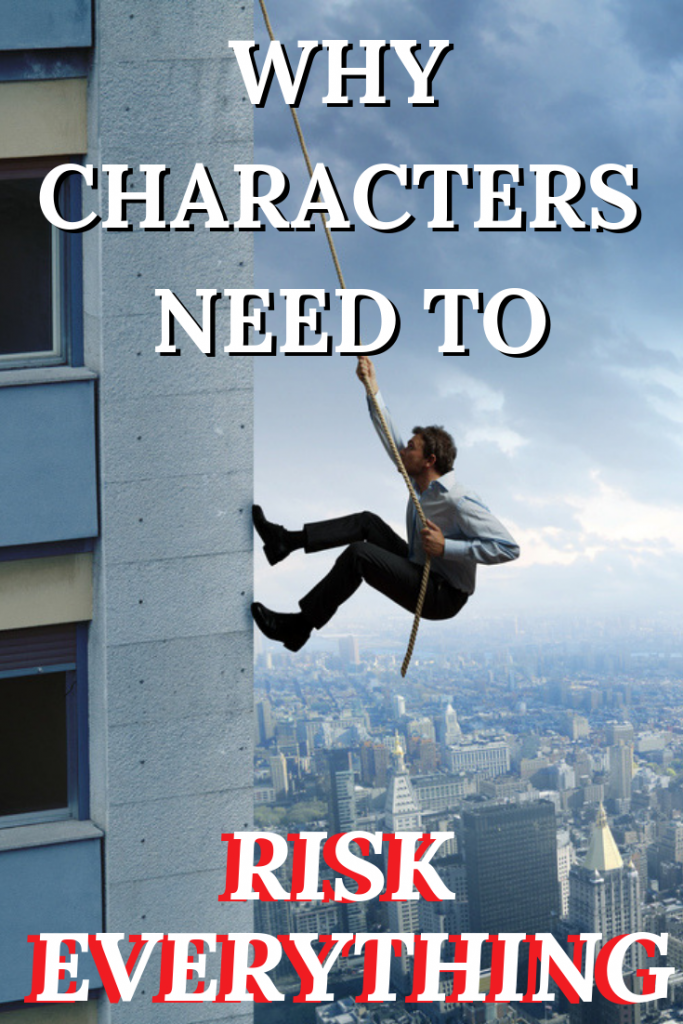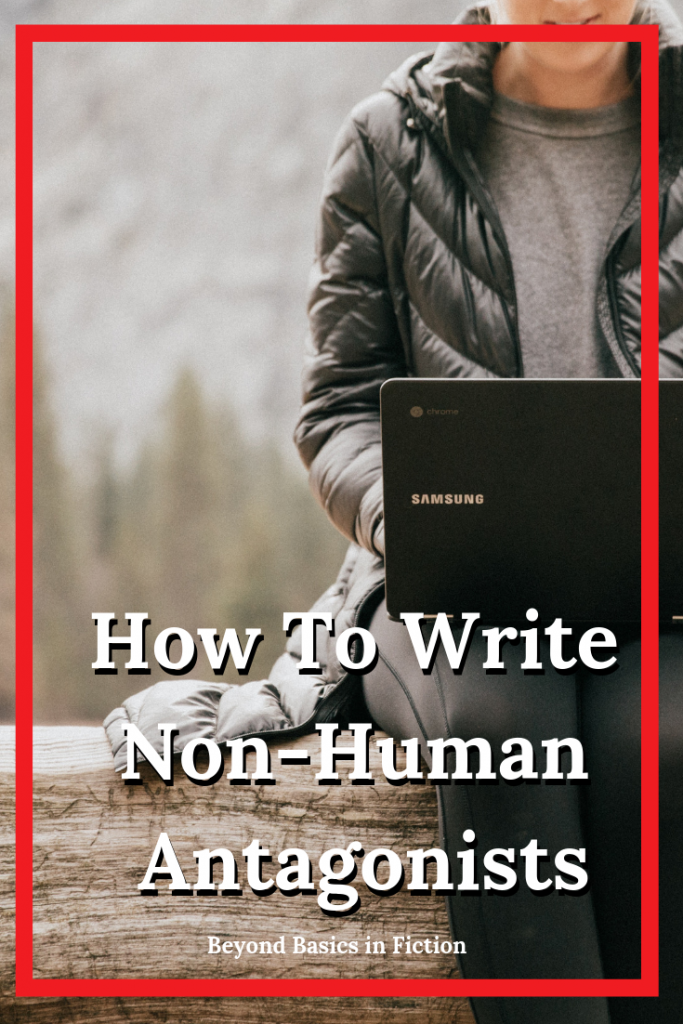
Your story needs a successful antagonist – one who wins a lot, who has odds overwhelmingly in their favor, moves the story ahead and directly challenges the protagonist’s story goal.
Without a powerful antagonist, your protagonist has nothing substantial to fight against—there’s little reason to cheer for them.
Ways to Make Your Antagonist Menacing
Backstory – Your antagonist needs a past and a history. Evil is grown not born. Even if it never comes out in the story, YOU need to know what made them like this.
Justified – Your antagonist is the hero of their own story and can rationally justify their thoughts and actions. Their actions and motivations are not random or nonsensical.
A Moral Code – Your antagonist can’t be completely bad all the time. Let them rescue kittens, love their moms, never break their word, whatever. Some antagonists have a moral framework they restrict themselves to—they only kidnap and murder men who abuse children, for instance. Anyone can fall in love, but who loves your antagonist? Is there something in your antagonist worth loving?
Heighten Tension –You know what Game of Thrones does really really well? There are some serious underdogs and overwhelming villains and antagonists. Here’s the key observation. The odds always remain in the favor of the bad guys and when it begins to tip the other way, a new antagonist emerges on the scene. The characters in the story rearrange themselves according to the actions of the antagonist.
You need a successful antagonist because if there’s no struggle, if the threat of loss for the main character isn’t imminent and devastating, there’s no underdog to cheer for.

The Inciting Incident Determines The Antagonist
Sometimes things can get really muddled in story land, and as the writer it’s hard to know exactly who or what is the main antagonist. Flip to the beginning of your story. What’s the inciting incident? Whatever problem is caused by the inciting incident is the main story problem and whatever is causing or in opposition to the main story problem is the antagonist—generally.
A man is marooned on a mountain in a snow storm. What’s his main story goal? If his main story goal is to survive and get off the mountain, the snow storm (nature) could be a valid antagonist. If his main story goal is to survive the storm, get off the mountain, and kill the person who left him stranded on the mountain, then the snow storm (nature) is merely an obstacle to his goal. Do you see the difference?
An antagonist actively works to prevent the protagonist from reaching their main story goal.
Antagonists vs Villains
The antagonist is the source of the opposing plot movement, and they get to win quite a bit right up until the end of your story. The antagonist is a role. The villain is any character who opposes your protagonist. (Consider Disney’s The Lion King. Scar is the antagonist and the hyenas Shenzi, Banzai, and Ed are villains. The hyenas oppose Simba but don’t move the plot ahead. Do you see the difference?)
In genres like romance, the hero/heroine can’t be the antagonist because the hero and the heroine must end up together (that’s a rule!). But, they are often at odds for most of the story. The antagonist is whatever person or force is keeping them apart. They will have to overcome obstacles, sometimes that obstacle is a villain, but the obstacles aren’t the antagonist. The antagonist must lose.
In Patricia Brigg’s novel Cry Wolf the main story problem is that Charles knows Anna is fated to be his mate, but she’s terrified of him. The antagonist is Anna’s fear, PTSD, anxiety, etc. However, there’s also a witch in the story – the witch isn’t keeping Charles and Anna apart, but she does present a story problem which Charles and Anna must work together to solve. The story problem is Anna’s fear of Charles, but the witch creates an ancillary story problem that presents an obstacle and serves as a plot device to force the hero and heroine to work together.
So, for the story to have a satisfying ending, Charles and Anna must defeat both the witch AND Anna’s fear. It’s important (read much much easier) for your character to fight a physical villain than themselves. It’s hard to portray that fight well. An ancillary villain provides the action and tension needed to represent the internal battle against the real antagonist.

The Case Of Dexter
Sometimes, the antagonist looks a lot like your protagonist. Take the example of television’s Dexter. Dexter is charming, holds down a job, was raised by a cop and lives his life by a strict moral code. However, Dexter kills people. He’s a serial killer. But Dexter is the protagonist – so how does that work?
Let’s dig a little deeper. At best, Dexter’s an anti-hero or even a villain protagonist — he can’t be both the protagonist and the antagonist.
We can get behind Dexter’s need for justice, his ability to act without caring what people think, his moral limits. But the antagonist in Dexter is actually his personality disorder – the psychopathy. The psychopathy is always just on the edge of winning out, of taking over, of silencing the (through voice overs) moral limits or obstacles Dexter places on himself.
The story obstacles in each episode would be the morals his father imposed on him and the laws and technology that might apprehend him from reaching his story goal (successfully murdering whoever he’s targeted).
Another example of this kind of antagonist construction is the film Flight with Denzel Washington. If serial killers aren’t your thing, Washington’s character’s main antagonist is alcoholism, but the investigation launched against him acts as an ancillary villain and story obstacles.
Who’s your favorite successful villain from movies, television, or books?
Been told you should learn Deep Point Of View? Had an editor or critique partner tell you to “go deeper” with the emotions in your fiction? Looking for a community of writers seeking to create emotional connections with readers? Check out the Free Resource Hub and then join the Going Deeper With Emotions In Fiction Facebook group.
Dear Lisa,
That’s a wonderful article. You rightly pointed out the difference between antagonist and the villain. The more powerful the antagonist of the story, the more appealing the story becomes. For example, Thanos (Avengers ), T1000( Terminator2 ) , Goddess Hella ( Thor Ragnarok) are larger than life antagonists where the superheroes actually felt helpless in defeating them and that’s the beauty of the plot. My favourite antagonist has to be Goddess Hella , crushed Thor’s hammer like a peanut. Thanks for the amazing post.
Regards.
Jamie
Jamie Smartkins recently posted…How to Motivate Employees at Work
Oooh – yes. Hella was a great antagnoist. I love Moriarty too. Somehow, even though Sherlock is brilliant, Moriarty always seems one step ahead.
Rightly said Lisa. Moriarty always ahead of Sherlock.
Jamie Smartkins recently posted…How to find happiness in life?